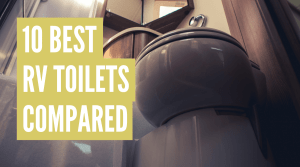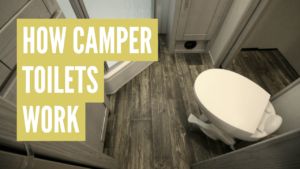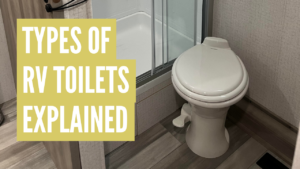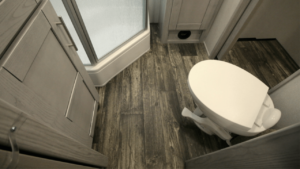Camper FAQs is reader-supported. Buying through links on our site may earn us an affiliate commission. As an Amazon Associate I earn from qualifying purchases.
Having a bad smell fill your RV every time the toilet is flushed can really put everyone’s mood down the drain (pun intended!).
This guide will help you diagnose why an RV toilet smells when flushed, how to fix it, and tips to prevent it from happening again.
Why Does My RV Toilet Stink When Flushed?
Understanding the common causes of RV toilet odors is the first step toward finding an effective solution. The most common reasons why your RV toilet smells like sewage when flushed include:
Clogging of the Toilet or Black Tank
One of the most common causes of RV toilet odors is a clog in the toilet or the black tank. This can occur when waste and toilet paper do not fully break down and accumulate in the pipe leading to the back tank or the tank itself. Over time, this buildup can lead to a clog, preventing the tank from emptying properly and causing an RV sewer smell when flushing.
Dirty Toilet
A dirty toilet can also be a source of bad smells. If the toilet bowl or seat is not cleaned regularly, bacteria can grow and produce odors. Additionally, residue from waste can stick to the sides of the toilet bowl, with the smell being exacerbated when flushed. Regular cleaning of the toilet can help prevent this issue.
Black Tank Buildup
Even with regular emptying, solid waste and residue can build up over time in the black tank. This buildup can be a breeding ground for bacteria, leading to strong odors. Regularly cleaning and treating the black tank can help prevent this buildup and keep odors at bay.
Blocked Roof Vent Pipe
The vent pipe allows gases from the black tank to escape outside the RV. If this pipe becomes blocked, these gases can build up in the tank and eventually find their way into the RV, causing a foul smell. Regularly checking the vent pipe for blockages can help prevent this issue.
Running the Vent Fan When Flushing
Running the vent fan when flushing the toilet can unintentionally contribute to RV toilet odors. The ventilation fan, designed to remove moisture and odors from the bathroom, can create a vacuum effect when in use. If the toilet is flushed while the fan is running, this vacuum can draw air up from the black tank, bringing odors into the RV living space.
This is particularly likely if the black tank is full or if there is a buildup of waste or residue in the tank that is producing strong odors. Even a clean and well-maintained black tank can produce some odors, and the suction effect of the vent fan can amplify these smells.
Leaking Toilet or Tank
Lastly, leaks in the toilet or black tank can also cause odors. If the seals around the toilet or the tank itself are not watertight, odors can escape into the RV. Regularly inspecting and maintaining the seals can help prevent leaks and the associated smells.
More often than not, these leaks will create a permanent sewage smell (and not just when flushing), but the smell can be exacerbated when flushing, so it’s worth looking into if none of the above are an issue.
The good news is that you can fix most RV toilet issues yourself. All you need are the right tools and the knowledge to solve the smelly problem.
However, if the toilet requires fixing due to system leaks or damages, you may have to seek an expert’s help.
How to Get Rid of RV Toilet Smells When Flushing
Here is my step-by-step process to keep your toilet from smelling when flushed, starting with the most likely culprit – the black tank.
Step 1: Clear Black Tank Clogs
If your RV toilet stinks when flushing it, it almost always means there is an RV black tank smell when flushing. This black tank smell is caused by a clog or buildup in the tank, so we must address these issues first.
Clogging results from solid waste buildup inside the tank or the pipe leading from the toilet to the black tank. And this usually happens from too much toilet paper/waste and not enough water. Remember, water is super important. The more liquid, the better.
If you do find yourself with a clog, and these things happen, you can unclog it using one of the following ways.
Use a Toilet Tank Wand
A flexible toilet wand is a versatile tool that you can use in your toilets and sinks that are predisposed to clogging. This commonly used tool can maneuver through the toilet drain into the tank and uses a high-pressure spray to remove the clogs.
When buying a toilet tank wand for your RV, find one with a nozzle that connects to the faucet with a flexible hose.

Camco RV Flexible Swivel Stik with Shutoff Valve
Price:Clicking this link to make a purchase may earn us a commission at no additional cost to you.
Pour Hot Water Down The Toilet
Pouring hot water into the toilet is a popular method to remove the clogs in your toilet system. And it works well!
Simply heat a pot of water, open the toilet valve, and pour the hot water down the toilet.
You can also add a little dishwasher soap with the hot water. The detergent may also help to break up the solid wastes and lubricate the system.
Use Septic Tank Safe Decloggers
You can also use septic-safe chemicals to unclog your RV toilets. These chemicals use special bacteria and enzymes designed to break down clogs in the black tank and pipes leading to and from it.

Unique Clear-It
Price:Clicking this link to make a purchase may earn us a commission at no additional cost to you.
For more information on toilet clogs, check out our in-depth guide to unclogging an RV toilet. And if you find that your black tank isn’t draining, check out our guide on how to unclog a black tank to get it draining again.
Step 2: Flush the Black Water Tank
Regularly flushing the black tank can help prevent waste buildup. And no waste buildup means no sewage or rotten egg smell wafting back into your bathroom when you flush.
Tip: Flush your RVs black tank after every camping trip to keep it clean and prevent solids from building up.
There are a few different ways you can flush and clean your tank:
- Black Water Tank Flush Port: Some RVs feature a built-in tank flushing system. It works by connecting to a water source, typically via a hose, and sending high-pressure jets of water into the tank to dislodge and remove solid waste and toilet paper. After rinsing, the wastewater is drained out through the sewer outlet.
- Handheld Backwasher: A handheld backwasher is a wand sprayer that can be inserted directly into the toilet. When connected to a water source, it releases a high-pressure stream of water that helps to dislodge and rinse away solid waste and toilet paper that may be stuck inside the tank. This tool provides a manual but effective method of maintaining the cleanliness and hygiene of the RV’s black water tank
- Black Tank Rinser: If your RV doesn’t have a flush port, a holding tank rinser can be used. This device connects between the holding tank outlet and the sewer hose. After installation, a garden hose is connected to the device, creating a high-flow water blast through the sewage pipe into the tank. This method is often preferred over using a handheld backwasher.
Check out our guide on how to clean out your RV black water tank for more information.
Step 3: Clean and Sanitize the Toilet
Maintaining cleanliness in your RV toilet is one of the most effective ways to keep your RV bathroom odor-free.
If you make it a habit to clean your toilet regularly, the chances are that your RV toilet system will function smoothly… and remain fresh smelling.
How to Clean the RV Toilet
We’ve already covered in-depth how to clean an RV toilet (check it out if you haven’t already), but at a high level, you’ll need to:
- Spray the toilet with toilet bowl cleaner and let it sit for 5-10 minutes.
- Scrub the bowl with a non-abrasive bowl brush.
- Rinse the toilet with a few flushes.
- While you’re at it, clean and disinfect the toilet seat and outside of the bowl.
Important: Be sure you do NOT use any harsh chemicals or scouring pads, as they can damage the toilet and void any potential warranty you might have.
Step 4: Clear Vent Pipe Clogs
Sometimes the clog isn’t in your toilet or tanks at all. Instead, it’s the pipe that vents the black tank to your RV’s roof.

When thtank vent pipe gets clogged, the smell has nowhere to go but out of your toilet when you flush.
To remedy this, insert a garden hose into the pipe at the roof opening and turn the water on to clear the clog. A toilet wand can also be used for this, and it works wonders for stubborn clogs.

Camco RV Flexible Swivel Stik with Shutoff Valve
Price:Clicking this link to make a purchase may earn us a commission at no additional cost to you.
Step 5: Inspect for Any Leaks or Damage
If none of the above has fixed the toilet smell issue, then look for any damage or leaks in your RV’s waste holding tank, sewage line, or toilet.
Tip: If the problem is a leak or impairment of the waste-holding tank, it’s best to get a quote from a professional to fix it. DIYs can be messy, especially in that specific part of the RV. Plus, you can potentially save on any unnecessary costs.
Do not forget to ensure that the toilet flap perfectly seals the toilet. If this does not fit properly, methane gas could leak out and cause a foul odor in your RV.
Luckily, leaks and damage to your RVs sewer system aren’t very common. And they typically aren’t the cause of your RV toilet smelling only when it’s flushed, but we have seen it happen.
Preventing RV Toilet Odors
To keep your toilet from smelling, you must understand how camper toilets work. Here are some things you need to know about an RV toilet system to keep it smelling fresh.
Water Is a Must for RV Toilets
And not just a little water, but lots!
Every time you use your RV toilet, fill it with water first and again after flushing. The more water, the better.
Using plenty of water will help prevent clogs in the plumbing and the waste in the black tank from becoming a giant solid mass that wafts a nasty smell back into your RV when you flush.
Tip: High temperatures can evaporate the liquids covering solid waste in the black tank, exposing the matter to the air. So be extra diligent about adding lots of water to your tanks in extremely hot weather.
Use a Holding Tank Treatment Product After Dumping
Using a holding tank treatment after dumping is another effective preventative measure. Tank treatments often contain bacteria and enzymes that help break down waste and control odors.
After emptying your black tank, add the recommended amount of treatment, followed by a few gallons of water. This creates a beneficial environment in the tank that can help prevent odors from developing between dumps.

Bio-Pak Natural Holding Tank Deodorizer and Waste Digester Drop-Ins
Price:Clicking this link to make a purchase may earn us a commission at no additional cost to you.
Using the Right Toilet Paper
Whether you should use regular toilet paper in an RV toilet is debatable, as many RVers think special bio-degradable TP is a waste of money.
No matter what side of the fence you’re on, if bad smells fill your RV every time you flush, you may want to try switching to a toilet paper that is biodegradable and sewer-tank safe.

Scott Rapid-Dissolving Toilet Paper
Price:Clicking this link to make a purchase may earn us a commission at no additional cost to you.
Why? Non-biodegradable toilet paper and flush wipe products are slower to break down. They can get stuck in the sewer system, which may cause clogs and other issues.
Keeping the Toilet Clean Is a Must
This one is self-explanatory. If there’s no clog or leak in the toilet or the waste holding tank, this only means that the toilet itself needs a good scrub down.
Although RV toilets are designed with heavy plastics or porcelain, dirt and waste can still stick to the surfaces. The solid waste buildup will dry up and cause a foul smell.
Tip: Regularly clean and, if needed, replace the bowl seal (gasket) to ensure the flapper completely closes after flushing. This will help prevent water leakage and odors from the holding tanks from entering your rig.
Run the Vent Fan After You Flush
Wait to run the vent fan in your bathroom after you flush the toilet to avoid odors getting sucked out of the black tank and into the living space. This simple habit can make a significant difference in controlling and preventing unpleasant RV toilet odors.







Thank you for all of this info.
I live in my trailer and have never had a gas smell cone up when I flush just had a guy check my vent on top it wasn’t clogged I guess?
Should I try hot water and dawn next down my toilet?
Hey Melody, that would be a good first step! If that doesn’t work I would recommend flushing the tank as we describe in step 2.
Okay Thank you!
WOW, thanks for this! After spending about an hour looking though forums i’m glad I found your guide. And for the record I use regular toilet paper, but maybe thats why i have an issue with bad odors! lol